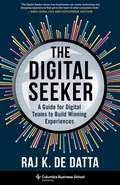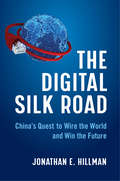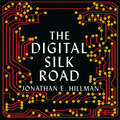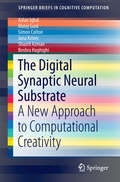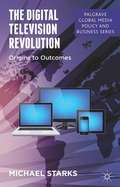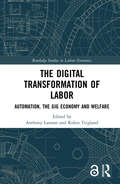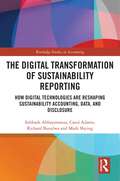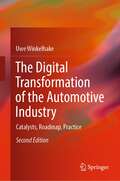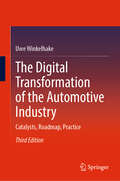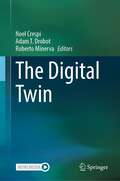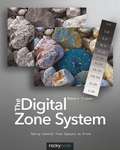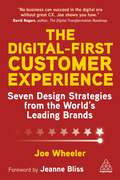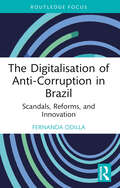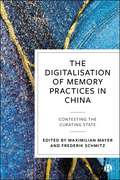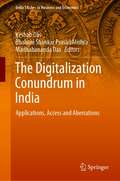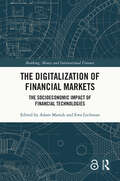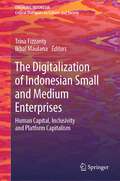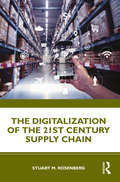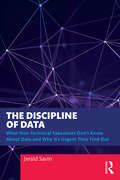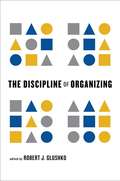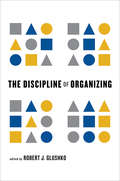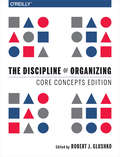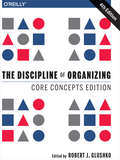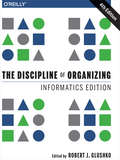- Table View
- List View
The Digital Seeker: A Guide for Digital Teams to Build Winning Experiences
by Raj K. DattaThe internet was supposed to connect us to endless possibilities. So why do we keep ending up browsing the same old sites and best-seller lists? When sellers don’t offer potential customers a compelling digital experience, consumers miss out on great products—and businesses miss a vital opportunity to grow.Raj K. De Datta, the founder of a company that powers digital-commerce experiences for many of the world’s biggest brands, offers an actionable playbook for companies looking to deliver better digital experiences. His key insight is that exceptional digital experiences are much more than marketplaces. They don’t just serve customers’ transactional needs but rather address the deeper problems for which they seek solutions. They are built on a digital-experience platform that provides agile, personalized, scalable performance. And they are created by product-centric digital teams, not traditional organizations.The Digital Seeker distills key lessons from the compelling stories of innovative businesses: not just tech companies but companies spanning a wide range of industries, including amusement parks, fashion, sports, health care, distribution, and the public sector. De Datta defines and explains the power of the seeker-centric philosophy—translating it into a core operational playbook for digital teams to achieve transformative results.Importantly, this book also offers crucial insights into the impact of the COVID-19 pandemic on our digital lives and the long-term effects it will have on digital experiences of the future.
The Digital Silk Road: China's Quest to Wire the World and Win the Future
by Jonathan E. HillmanAn expert on China’s global infrastructure expansion provides an urgent look at the battle to connect and control tomorrow’s networks.From the ocean floor to outer space, China’s Digital Silk Road aims to wire the world and rewrite the global order. Taking readers on a journey inside China’s surveillance state, rural America, and Africa’s megacities, Jonathan Hillman reveals what China’s expanding digital footprint looks like on the ground and explores the economic and strategic consequences of a future in which all routers lead to Beijing.If China becomes the world’s chief network operator, it could reap a commercial and strategic windfall, including many advantages currently enjoyed by the United States. It could reshape global flows of data, finance, and communications to reflect its interests. It could possess an unrivaled understanding of market movements, the deliberations of foreign competitors, and the lives of countless individuals enmeshed in its networks. However, China’s digital dominance is not yet assured. Beijing remains vulnerable in several key dimensions, the United States and its allies have an opportunity to offer better alternatives, and the rest of the world has a voice. But winning the battle for tomorrow’s networks will require the United States to innovate and take greater risks in emerging markets. Networks create large winners, and this is a contest America cannot afford to lose.
The Digital Silk Road: China's Quest to Wire the World and Win the Future
by Jonathan E. HillmanIts vast infrastructure projects now extend from the ocean floor to outer space, and from Africa's megacities into rural America. China is wiring the world, and, in doing so, rewriting the global order.As things stand, the rest of the world still has a choice. But the battle for tomorrow will require America and its allies to take daring risks in uncertain political terrain. Unchecked, China will reshape global flows of data to reflect its interests. It willdevelop an unrivalled understanding of market movements, the deliberations of foreign competitors, and the lives of countless individuals enmeshed in its systems. Networks create large winners, and this is one contest that democracies can't afford to lose.Taking readers on a global tour of these emerging battlefields, Jonathan Hillman reveals what China's digital footprint looks like on the ground, and explores the dangers of a world in which all routers lead to Beijing.
The Digital Synaptic Neural Substrate
by Azlan Iqbal Matej Guid Simon Colton Jana Krivec Shazril Azman Boshra HaghighiThis book describes a new computational approach to creativity. With chess as the domain of investigation, the authors show experimentally how a computer can be imbued with the 'spark' of creativity that enables it to compose chess problems or puzzles that are both challenging and aesthetically appealing to humans. This new approach called the Digital Synaptic Neural Substrate (DSNS) mimics the brain's ability to combine fragments of seemingly unrelated information from different domains (such as chess, photographs and music) to inspire itself to create new objects in any of them. Representing the cutting edge in computational creativity research, this book will be useful to students, educators and researchers in the field as well as artificial intelligence (AI) practitioners, in general.
The Digital Television Revolution: Origins To Outcomes (Palgrave Global Media Policy and Business)
by Michael StarksThis account of the global switch to digital television, from its origins to its emerging outcomes, provides an understanding of how digital television is converging with the Internet. It pictures a future in which the democratic role of the media, freedom of expression and democratic participation can be enhanced.
The Digital Transformation of Labor: Automation, the Gig Economy and Welfare (Routledge Studies in Labour Economics)
by Robin Teigland Anthony LarssonThrough a series of studies, the overarching aim of this book is to investigate if and how the digitalization/digital transformation process causes (or may cause) the autonomy of various labor functions, and its impact in creating (or stymieing) various job opportunities on the labor market. This book also seeks to illuminate what actors/groups are mostly benefited by the digitalization/digital transformation and which actors/groups that are put at risk by it. This book takes its point of departure from a 2016 OECD report that contends that the impact digitalization has on the future of labor is ambiguous, as on the one hand it is suggested that technological change is labor-saving, but on the other hand, it is suggested that digital technologies have not created new jobs on a scale that it replaces old jobs. Another 2018 OECD report indicated that digitalization and automation as such does not pose a real risk of destroying any significant number of jobs for the foreseeable future, although tasks would by and large change significantly. This would affects welfare, as most of its revenue stems from taxation, and particularly so from the taxation on labor (directly or indirectly). For this reason, this book will set out to explore how the future technological and societal advancements impact labor conditions. The book seeks to provide an innovative, enriching and controversial take on how various aspects of the labor market can be (and are) affected the ongoing digitalization trend in a way that is not covered by extant literature. As such, this book intends to cater to a wider readership, from a general audience and students, to specialized professionals and academics wanting to gain a deeper understanding of the possible future developments of the labor market in light of an accelerating digitalization/digital transformation of society at large.
The Digital Transformation of Sustainability Reporting: How Digital Technologies are Reshaping Sustainability Accounting, Data, and Disclosure (Routledge Studies in Accounting)
by Richard Busulwa Carol Adams Subhash Abhayawansa Mark ShyingAs global sustainability expectations intensify, digital technologies (DTs) are becoming essential tools for efficiently and effectively managing, measuring, and communicating sustainability performance and impact. This book unpacks how emerging and established DTs, from artificial intelligence and blockchain to cloud platforms and the Internet of Things, can transform sustainability reporting and data management, enhance decision‑making, and improve accountability across value chains.Drawing on insights from extensive interviews and cross‑sectional surveys of sustainability, accounting, auditing, data science and technology professionals, this book delivers a practical and evidence‑based roadmap of how DTs are being leveraged and could be better leveraged in internal and external sustainability reporting‑related activities. It explores how DTs can enhance the efficiency and effectiveness of collecting, analysing, and assuring sustainability‑related data, while also supporting scenario planning, target setting, and improving the accessibility and usability of disclosures for stakeholders. This book further examines the key drivers, opportunities, and challenges shaping the use of DTs in sustainability reporting and offers a valuable reference for practitioners and finance professionals through a concise mapping of relevant digital tools and platforms. It also explores the evolving roles and competencies required of accounting and finance professionals to effectively contribute to sustainability reporting and lead technology‑enabled sustainability performance.This is a must‑read for: Sustainability managers and leaders seeking more efficient, credible, and future‑ready sustainability reporting practices Policymakers and regulators navigating the digitalisation of corporate transparency and compliance Technology providers aiming to align product innovation with the fast‑evolving needs of sustainability reporting Educators and students in accounting, finance, sustainability, and data science fields preparing for the future of sustainability‑driven business Researchers exploring the intersection of digital innovation, regulatory change, and reporting of sustainability risks, performance, and impacts
The Digital Transformation of the Automotive Industry: Catalysts, Roadmap, Practice
by Uwe WinkelhakeBuilding on his decades of experience as a consultant and project manager in the automotive industry, the author develops comprehensive and pragmatic recommendations for action regarding the digital transformation of the automotive and supplier industries. At the heart is the transition from a vehicle-focused to a mobility-oriented business model. Based on the catalysts of the digital change, four digitizsation fields are structured, and a roadmap for their transformation is presented. The topics of comprehensive change in corporate culture and an agile and efficient information technology are covered in detail as vital success factors. Selected practical examples of innovative digitizsation projects provide additional ideas and impulses. An outlook on the automotive industry in the year 2040 completes the discourse.
The Digital Transformation of the Automotive Industry: Catalysts, Roadmap, Practice
by Uwe WinkelhakeThis book provides comprehensive and pragmatic recommendations for action for the automotive and supplier industry, which has been changing ever more rapidly in recent years. China has developed into the leading market for e-mobility and for the use of autonomous robotaxis, AI and data. The established manufacturers have to change much more quickly based on clear objectives in order not to lose touch and to still be able to achieve the Paris climate goals. The industry is changing comprehensively from a vehicle-focused to a mobility-oriented business model. More and more processes, even entire business areas, will run automatically based on AI and new technologies will change sales and aftersales structures. More and more data is being created, which also enables new, profitable products. The switch to e-vehicles with an appropriate charging environment, the use of mobility services instead of car ownership, climate-neutral production and the circular economy must be addressed more quickly. The third edition of the book provides complete information on the digital transformations that are still absolutely necessary and taking into account the latest developments revised edition comprehensive and pragmatic answers to current questions: How should new technologies be used in a structured manner and where will AI lead to significant changes? How should the transformation be approached and with what key topics? The outlook beyond 2040 at the end of the book has been expanded and the expected changes in the world of work are considered, especially from an AI perspective. Regarding the digital transformations that are still absolutely necessary and taking into account the latest developments, the book, now in its third completely revised edition, provides comprehensive and pragmatic answers to current questions: How should new technologies be used in a structured manner and where will AI lead to significant changes? How should the transformation be approached and with what key topics? The outlook beyond 2040 at the end of the book has been expanded and the expected changes in the world of work are considered, especially from an AI perspective.
The Digital Twin
by Roberto Minerva Noel Crespi Adam T. DrobotThe Digital Twin is crucial and timely for positively affecting how we work, live, and play. It eliminates the gap between experimentation and learning by bridging real and virtual worlds in a powerful methodology, making significant headway in conquering previously unsolvable problems and challenges. Digital Twins are made possible by four widely deployed infrastructures for connectivity, computing, digital storage, and sources of digital data. The Digital Twin provides insights, paths to innovation, efficient production of goods, improved delivery of services, better experiences and entertainment, and new business models. Investing in Digital Twins is one of the most valuable ways to create sustainable paths to the future. The Digital Twin book is the most comprehensive work on the subject to date. It brings together top practitioners, technical experts, analysts, and academics to explore and discuss the concept of the Digital Twin, its history, evolution, and the profound impact across sectors of the global economy. The book addresses the business value, technological underpinnings, lessons learned from implementations, resources for success, practical approaches for implementation, and illustrative use cases. It makes the case for why we believe that Digital Twins will fundamentally transform major industries and enable us to fulfill important societal goals. The book is recommended for key decision makers, senior executives, technical leaders, researchers, and students.
The Digital Zone System: Taking Control from Capture to Print
by Robert FisherThere is an ongoing debate among photographers whether digital photography processes will ever be able to reach the pinnacle of image quality and tonality achieved by Ansel Adams decades ago. The Digital Zone System (DZS) is an innovative methodology for editing digital images that mimics the Zone System created by Adams. With this book, author Robert Fisher presents a practical guide for editing digital images with a level of control previously unattainable without significant manual work. He walks the reader through the background of Adam's original Zone System and points out similarities to current digital processes including Expose to the Right (ETTR) and high dynamic range imaging (HDRI). Learn to use luminance masks to separate an image into "one-stop" zones of brightness, similar to the zones in Adams's Zone System, that can be worked on individually or in groups. This makes the DZS a powerful tool for converting color images to black and white. You will also gain tremendous control over how color is adjusted in your images by learning to isolate and adjust color in specific targeted areas. These DZS processes are quicker and simpler than the tedious work of using global adjustments and painting in layer masks to isolate the effects of an adjustment layer. In this book, you will learn how to use the Digital Zone System for editing color images, converting images to black and white, and tone mapping HDR images. Also included are brief discussions of color management, setting up Photoshop, printing, and exposure for digital images. The book is richly illustrated with step-by-step screenshots and stunning example images that show the benefits of the Digital Zone System over commonly used digital editing methods. Once mastered, the DZS will allow you to produce a higher level of quality in your images, at a faster pace and with greater ease than ever before.
The Digital-First Customer Experience: Seven Design Strategies from the World’s Leading Brands
by Joe WheelerThe definitive guide to designing digital-first experiences customers love. In his third book on the topic of customer experience, bestselling author and consultant Joe Wheeler tackles the challenges many organizations are facing as they attempt to design compelling experiences in a digital-first world. It features case studies of leading brands including Lemonade, Spotify, CEMEX, VMware, Starbucks, NIKE and Amazon.Part One introduces the new "3 Cs", key trends associated with technology convergence, competition and culture change in a post-pandemic world. Part Two takes a deep dive into seven design strategies, from designing emotional peaks across channels to empowering customers through immersive experiences that merge physical and digital assets. Part Three provides a playbook for how to design digital-first experiences, including how to solve the right problems, develop a measurable business case, design digital-first experiences customers love and execute the new design at scale.
The Digitalisation of Anti-Corruption in Brazil: Scandals, Reforms, and Innovation (ISSN)
by Fernanda OdillaThis book investigates how digital technologies, such as social media and artificial intelligence, can contribute to combatting corruption in Brazil.Brazil, with its long history of scandals and abundant empirical data on digital media usage, serves as a perfect case study to trace the development of bottom-up and top-down digital anti-corruption technologies and their main features. This book highlights the connections between anti-corruption reforms and the rapid implementation of innovative solutions, primarily developed by tech-savvy public officials and citizens committed to anti-corruption efforts. The book draws on interviews with experts, activists and civil servants, as well as open-source materials and social media data to identify key actors, their practices, challenges and limitations of anti-corruption technologies. The result is a thorough analysis of the process of digitalisation of anti-corruption in Brazil, with a theoretical framework which can also be applied to other countries. The book introduces the concept of “integrity techies” to encompass social and political actors who develop and facilitate anti-corruption technologies, and discusses different outcomes and issues associated with digital innovation in anti-corruption.This book will be a key resource for students, researchers and practitioners interested in technologies and development in Brazil and Latin America, as well as corruption and anti-corruption studies more broadly.
The Digitalisation of Memory Practices in China: Contesting the Curating State
by Maximilian Mayer and Frederik SchmitzHow is memory in China curated in the digital era? This pioneering volume investigates the transformation of collective memory in China amid rapid technological change. Introducing the concept of the “curating state,” it reveals how digitalisation both supports and challenges official memories, giving rise to more hybrid and, at times, democratised memory practices. Bringing together leading Chinese and international scholars, the book examines the use of digital tools by state, private and commercial actors to curate their own versions of the past. Combining theoretical innovation with rich empirical research, this is a vital resource for understanding the dynamic interplay between memory, media and power in contemporary China—and beyond.
The Digitalization Conundrum in India: Applications, Access and Aberrations (India Studies in Business and Economics)
by Keshab Das Bhabani Shankar Prasad Mishra Madhabananda DasThis book examines the nature, extent and implications of rapid strides digitalization has made in India since the turn of the millennium. These have been examined not merely in the sphere of information and communication technology (ICT) but its multifarious applications spreading across almost all aspects of production, services and institutions which have profound repercussions for the transformation of the society and economy at the micro, meso and macro levels. With contributions from both ICT scholars and social scientists, this book presents diverse scenarios and unravels challenges faced in the process of technical applications, access by the users of these disruptive technologies (automation, e-commerce, big data analytics & algorithms, artificial intelligence, cloud computing, etc.) which, unlike heavy machines (embodied technology), mostly defy physical space, pace of mobility and inoperability between technologies. Chapters in this volume address challenges and possibilities in establishing and operating intricate engineering infrastructure, technical and societal constraints encountered in broad-basing digitalization across layers of educational and social skills conducive to difficult geographies. Issues dealt within this book include farming, healthcare, education, food processing, e-commerce, labour, rural community development, open source data and information democracy. The chapters also reflect upon implications on local economy and society, of the very global nature of these seamless technologies where inter-operability remains the quintessential advantage of digitalization whether promoted or spearheaded through the state, private sector or global capital. The book critiques policy inadequacies and suggests plausible policy approaches to reduce the adverse impacts of fast digitalization and broad-base potential benefits across space and levels of socio-economic development of regions and society. This book would be of interest to scholars, practitioners, technocrats, industry analysts, policy makers and civil society agencies.
The Digitalization of Financial Markets: The Socioeconomic Impact of Financial Technologies (Banking, Money and International Finance)
by Ewa Lechman Adam MarszkThe book provides deep insight into theoretical and empirical evidence on information and communication technologies (ICT) as an important factor affecting financial markets. It is focused on the impact of ICT on stock markets, bond markets, and other categories of financial markets, with the additional focus on the linked FinTech services and financial institutions. Financial markets shaped by the adoption of the new technologies are labeled ‘digital financial markets’. With a wide-ranging perspective at both the local and global levels from countries at varying degrees of economic development, this book addresses an important gap in the extant literature concerning the role of ICT in the financial markets. The consequences of these processes had until now rarely been considered in a broader economic and social context, particularly when the impact of FinTech services on financial markets is taken into account. The book’s theoretical discussions, empirical evidence and compilation of different views and perspectives make it a valuable and complex reference work. The principal audience of the book will be scholars in the fields of finance and economics. The book also targets professionals in the financial industry who are directly or indirectly linked to the new technologies on the financial markets, in particular various types of FinTech services.
The Digitalization of Indonesian Small and Medium Enterprises: Human Capital, Inclusivity and Platform Capitalism (Engaging Indonesia)
by Trina Fizzanty Ikbal MaulanaThis book examines the digitalization of Small and Medium Enterprises (SMEs) in Indonesia and its challenges in the context of an emerging economy and the Covid-19 crisis. During the Covid-19 pandemic, business digitalization became a must for a business to avoid collapse and people saw that digital transformation is a panacea for SMEs to help them survive and revive from the crises. Governments and other stakeholders in many countries including Indonesia have launched policies and programs to support SMEs. Transforming SMEs' conventional businesses into digitalized versions, however, is a complex issue influenced by various factors. These factors encompass both internal changes within the organization and external dynamics in the ecosystem in which they operate. This book, therefore, is a new approach towards understanding the digitalization of SMEs in Indonesia and includes contributions from scholars with different, multi-disciplinary perspectives and demonstrates that digital transformation of SMEs is not all about technology adoption but also involves other aspects such as social, economic, and public governance factors. It discusses opportunities and challenges of digital transformation of SMEs in Indonesia, such as digital talent, financial inclusion, platform capitalism, automation, government’s role, governance, open competition, and inclusive digital economy. The book is of interest to researchers and students of social economics, SMEs and entrepreneurship, human capital research, and economy and governance.
The Digitalization of the 21st Century Supply Chain
by Stuart M. RosenbergThe goal of this book is to gain a clear picture of the current status and future challenges with regard to the digitalization of the supply chain – from the perspective of the suppliers, the manufacturers, and the customers. They were the target groups of the book. Digitization has touched upon all aspects of businesses, including supply chains. Technologies such as RFID, GPS, and sensors have enabled organizations to transform their existing hybrid (combination of paper-based and IT-supported processes) supply chain structures into more f lexible, open, agile, and collaborative digital models. Unlike hybrid supply chain models, which have resulted in rigid organizational structures, unobtainable data, and disjointed relationships with partners, digital supply chains enable business process automation, organizational flexibility, and digital management of corporate assets. In order to reap maximum benefits from digital supply chain models, it is important that companies internalize it as an integral part of the overall business model and organizational structure. Localized disconnected projects and silo-based operations pose a serious threat to competitiveness in an increasingly digital world. The technologies discussed in this text – artificial intelligence, 3D printing, Internet of things, etc. – are beginning to come together to help digitize, automate, integrate, and improve the global supply chains. It’s certainly an exciting and challenging time for both new supply chain professionals and long-time supply chain professionals.
The Discipline of Data: What Non-Technical Executives Don't Know About Data and Why It's Urgent They Find Out
by Jerald SavinPulling aside the curtain of ‘Big Data’ buzz, this book introduces C-suite and other non-technical senior leaders to the essentials of obtaining and maintaining accurate, reliable data, especially for decision-making purposes. Bad data begets bad decisions, and an understanding of data fundamentals — how data is generated, organized, stored, evaluated, and maintained — has never been more important when solving problems such as the pandemic-related supply chain crisis. This book addresses the data-related challenges that businesses face, answering questions such as: What are the characteristics of high-quality data? How do you get from bad data to good data? What procedures and practices ensure high-quality data? How do you know whether your data supports the decisions you need to make? This clear and valuable resource will appeal to C-suite executives and top-line managers across industries, as well as business analysts at all career stages and data analytics students.
The Discipline of Data: What Non-Technical Executives Don't Know About Data and Why It's Urgent They Find Out
by Jerald SavinPulling aside the curtain of ‘Big Data’ buzz, this book introduces C-suite and other non-technical senior leaders to the essentials of obtaining and maintaining accurate, reliable data, especially for decision-making purposes. Bad data begets bad decisions, and an understanding of data fundamentals — how data is generated, organized, stored, evaluated, and maintained — has never been more important when solving problems such as the pandemic-related supply chain crisis. This book addresses the data-related challenges that businesses face, answering questions such as: What are the characteristics of high-quality data? How do you get from bad data to good data? What procedures and practices ensure high-quality data? How do you know whether your data supports the decisions you need to make? This clear and valuable resource will appeal to C-suite executives and top-line managers across industries, as well as business analysts at all career stages and data analytics students.
The Discipline of Organizing
by Robert J. Glushko et alAbstract: We organize things, we organize information, we organize information about things, and we organize information about information. But even though "organizing" is a fundamental and ubiquitous challenge, when we compare these activities their contrasts are more apparent than their commonalities. We propose to unify many perspectives about organizing with the concept of an Organizing System, defined as an intentionally arranged collection of resources and the interactions they support. Every Organizing System involves a collection of resources, a choice of properties or principles used to describe and arrange resources, and ways of supporting interactions with resources. By comparing and contrasting how these activities take place in different contexts and domains, we can identify patterns of organizing. We can create a discipline of organizing in a disciplined way.
The Discipline of Organizing (The\mit Press Ser.)
by Robert J. Glushko et alA framework for the theory and practice of organizing that integrates the concepts and methods of information organization and information retrieval.Organizing is such a common activity that we often do it without thinking much about it. In our daily lives we organize physical things—books on shelves, cutlery in kitchen drawers—and digital things—Web pages, MP3 files, scientific datasets. Millions of people create and browse Web sites, blog, tag, tweet, and upload and download content of all media types without thinking “I'm organizing now” or “I'm retrieving now.”This book offers a framework for the theory and practice of organizing that integrates information organization (IO) and information retrieval (IR), bridging the disciplinary chasms between Library and Information Science and Computer Science, each of which views and teaches IO and IR as separate topics and in substantially different ways. It introduces the unifying concept of an Organizing System—an intentionally arranged collection of resources and the interactions they support—and then explains the key concepts and challenges in the design and deployment of Organizing Systems in many domains, including libraries, museums, business information systems, personal information management, and social computing.Intended for classroom use or as a professional reference, the book covers the activities common to all organizing systems: identifying resources to be organized; organizing resources by describing and classifying them; designing resource-based interactions; and maintaining resources and organization over time. The book is extensively annotated with disciplinary-specific notes to ground it with relevant concepts and references of library science, computing, cognitive science, law, and business.
The Discipline of Organizing: Core Concepts Edition
by Robert J. GlushkoNote about this ebook: This ebook exploits many advanced capabilities with images, hypertext, and interactivity and is optimized for EPUB3-compliant book readers, especially Apple's iBooks and browser plugins. These features may not work on all ebook readers.We organize things. We organize information, information about things, and information about information. Organizing is a fundamental issue in many professional fields, but these fields have only limited agreement in how they approach problems of organizing and in what they seek as their solutions.The Discipline of Organizing synthesizes insights from library science, information science, computer science, cognitive science, systems analysis, business, and other disciplines to create an Organizing System for understanding organizing. This framework is robust and forward-looking, enabling effective sharing of insights and design patterns between disciplines that weren't possible before.Ideal as a textbook for undergraduates, the Core Concepts Edition includes new and revised content about the active resources of the "Internet of Things," and how the field of Information Architecture can be viewed as a subset of the discipline of organizing. You'll find:Stop and Think exercises designed to increase engagement and comprehensionUser-contributed case studies to help you with your own organizing problemsNearly 60 new pictures and illustrationsLinks to cross-references and external citationsInteractive study guides to test on key points
The Discipline of Organizing: Core Concepts Edition
by Robert J. GlushkoWe organize things. We organize information, information about things, and information about information. Organizing is a fundamental issue in many professional fields, but these fields have only limited agreement in how they approach problems of organizing and in what they seek as their solutions. The Discipline of Organizing synthesizes insights from library science, information science, computer science, cognitive science, systems analysis, business, and other disciplines to create an Organizing System for understanding organizing. This framework is robust and forward-looking, enabling effective sharing of insights and design patterns between disciplines that weren't possible before. The 4th edition of this award-winning and widely adopted text adds content to bridge between the foundations of organizing systems and the new statistical and computational techniques of data science because at its core, data science is about how resources are described and organized. The 4th edition reframes descriptive statistics as organizing techniques, expands the treatment of classification to include computational methods, and incorporates many new examples of data-driven resource selection, organization, maintenance, and personalization. The Core Concepts edition is an abridged version that is simpler to read because it does not tempt the reader with the deep scholarly web of endnotes contained in the Professional edition. Instead, it seeks to reinforce the concepts and design patterns with numerous "Stop and Think" exercises, and omits some of the theoretical nuance of the Professional edition to put more emphasis on concrete examples.
The Discipline of Organizing: Informatics Edition
by Robert J. GlushkoWe organize things. We organize information, information about things, and information about information. Organizing is a fundamental issue in many professional fields, but these fields have only limited agreement in how they approach problems of organizing and in what they seek as their solutions. The Discipline of Organizing synthesizes insights from library science, information science, computer science, cognitive science, systems analysis, business, and other disciplines to create an Organizing System for understanding organizing. This framework is robust and forward-looking, enabling effective sharing of insights and design patterns between disciplines that weren't possible before. The 4th edition of this award-winning and widely adopted text adds content to bridge between the foundations of organizing systems and the new statistical and computational techniques of data science because at its core, data science is about how resources are described and organized. The 4th edition reframes descriptive statistics as organizing techniques, expands the treatment of classification to include computational methods, and incorporates many new examples of data-driven resource selection, organization, maintenance, and personalization. The Informatics edition contains all the new content related to data science, but omits the discipline-specific content about library science, museums, and document archives.
